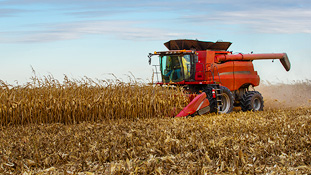Large machinery fires — including those on and in farm combines and harvesters — cause around $20 million in property losses, untold millions in lost productivity and up to 50 serious personal injuries every year. But they can be prevented with attention to the three components of farm combine fire safety.
“Think in terms of how important prevention, detection and suppression all are to keeping your farm operation in business,” said Nationwide Risk Management Director Kelly Grummert. “The whole goal of all three components of combine fire safety is to prevent machinery loss, protect the operator and ensure they all go home to their families every night.”
1. Inspect your combine harvester to minimize fire risk
Attention to fire safety starts well before a farm combine or harvester wheel turns. It starts at the farm shop or wherever a machine is stored year-round. Add the following to your routine post-harvest maintenance inspections to minimize fire risks:
- Clean crop residue or engine fluids like fuel or grease around the machine that could easily ignite in the presence of an external heat source.
- Clear plant material from bearings, belts and other potentially heat-generating components.
- Follow manufacturer’s recommendations for maintenance and lubrication prior to storing your harvester for a long period of time, paying close attention for potential leaks in hoses or fittings.
- Make sure your machine is stored away from external heat sources like furnaces or other heating elements that can lead to fire.
2. Monitor equipment for excessive heat
Fast forward a few months to harvest; once ready to hit the field, that’s when your farm combine or harvester safety should broaden to include fire detection and notification.
Advancing sensor technology available today can monitor heat generated around key components to ensure they’re within operating temperature ranges and aren’t creating enhanced fire risk.
“If it’s getting too hot, sensors will alert the farmer so he or she can take quick action to prevent overheating from developing into a fire,” Grummert said.
Thermal imaging can also help with fire detection. Because equipment can show problems in the form of excessive heat before they fail, early identification of anomalies is a critical step in preventing possible combine fires.
